
_sinking_after_a_Kamikaze_attack_off_Okinawa%252C_10_June_1945.jpg.webp)
For the April 1945 invasion of Okinawa (Allied codename: Operation Iceberg), the Allies assembled the most powerful naval force in history. Since the few remaining capital ships of the Imperial Japanese Combined Fleet had been sunk or otherwise put out of action at the Battle of Leyte Gulf, the Allies were effectively unopposed in terms of major surface vessels; a single mission consisting of the superbattleship Yamato and a few escorts was undertaken, but the task force did not get within 200 nautical miles (370 km; 230 mi) of the invasion area. The main Japanese naval opposition within the invasion area came from hundreds of Imperial Japanese Navy Shin'yō-class suicide motorboats and Maru-Ni Imperial Japanese Army attack boats.
Since the Japanese air arm had been equally decimated by this point in the war, the lack of trained and experienced pilots led them to deploy the kamikaze extensively in the waters off Okinawa.
![]() US Navy combat ships:
US Navy combat ships:
11 fleet carriers, 6 light carriers, 22 escort carriers, 8 fast battleships, 10 old battleships, 2 large cruisers, 12 heavy cruisers, 13 light cruisers, 4 anti-aircraft light cruisers, 132 destroyers, 45 destroyer escorts
![]() Amphibious assault vessels:
Amphibious assault vessels:
84 attack transports, 29 attack cargo ships, LCIs, LSMs, LSTs, LSVs, etc.
![]() Auxiliaries:
Auxiliaries:
52 submarine chasers, 23 fast minesweepers, 69 minesweepers, 11 minelayers, 49 oilers, etc.
![]() Royal Navy combat ships:
Royal Navy combat ships:
5 fleet carriers, 2 battleships, 7 light cruisers, 14 destroyers
Losses
The smaller ships were least able to withstand damage from kamikaze attacks.
- 12 to kamikaze: Twiggs, Mannert L. Abele, Callaghan, William D. Porter, Pringle, Bush, Dickerson, Emmons, Swallow, Canada Victory, Logan Victory, Hobbs Victory
- 2 to mines: Halligan, Skylark
- 1 to collision: Thornton
Allied command structure

.jpg.webp)



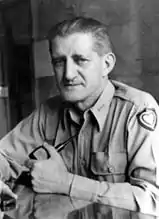
Naval
The roles of Commander in Chief, Pacific Ocean Areas (CINCPOA) and Commander in Chief, U.S. Pacific Fleet (CINCPAC) were both exercised by Admiral Chester W. Nimitz from his headquarters at Pearl Harbor, Hawaii.
Since the "Big Blue Fleet" was at this time under the command of Admiral Raymond Spruance aboard his flagship USS Indianapolis, the force was designated Fifth Fleet. (It had been Third Fleet until Spruance relieved Admiral William Halsey in January, as part of the "alternating command" system).
The ships and troops of Operation Iceberg were under direct operational command of Rear Admiral Richmond Kelly Turner aboard amphibious command ship Eldorado.
Ground troops
Son of a Confederate army general, Lt. Gen. Simon Bolivar Buckner, Jr. was one of four US lieutenant generals to die during World War II, but the only one to die by enemy action. On 18 June, Buckner was visiting a forward observation post when a Japanese artillery shell struck a coral outcropping, fragments of which struck Buckner in the chest. Command of Tenth Army passed to Marine Maj. Gen. Roy S. Geiger.
United States Tenth Army (Lt. Gen. Simon Bolivar Buckner, Jr. (KIA))
- Tactical Air Force, Tenth Army - MajGen Francis P. Mulcahy/MajGen Louis E. Woods
- III Amphibious Corps (Maj. Gen. Roy S. Geiger)
- Left beaches: 6th Marine Division (Maj. Gen. Lemuel C. Shepherd, Jr.)
- Right beaches: 1st Marine Division (Maj. Gen. Pedro A. del Valle)
- XXIV Army Corps (Maj. Gen. John R. Hodge)
- Left beaches: 7th Infantry ("Bayonet") Division (Maj. Gen. A.V. Arnold)
- Right beaches: 96th Infantry ("Deadeye") Division (Maj. Gen. J.L. Bradley)
- Landed L+8: 27th Infantry ("New York") Division (Maj. Gen. G.W. Griner, Jr.)
Allied amphibious forces
Joint Expeditionary Force (Task Force 51)
_off_the_Mare_Island_Navy_Yard_in_1944.jpg.webp)
_in_early_1950s.jpg.webp)
Vice Admiral Richmond Kelly Turner in amphibious command ship Eldorado
- Western Islands Attack Group (Task Group 51.1)
_at_anchor%252C_in_1945.jpg.webp)
_off_Boston%252C_Massachusetts_(USA)%252C_on_20_October_1944_(BS_76150).jpg.webp)
_underway_near_Baltimore%252C_Maryland_(USA)%252C_circa_in_April_1944_(19-N-63509).jpg.webp)
.jpg.webp)
_in_San_Francisco_Bay%252C_California_(USA)%252C_circa_in_late_1945_(NH_98728).jpg.webp)
- Rear Admiral I.N. Kiland in amphibious command ship Mount McKinley
- Embarking 77th Infantry ("Statue of Liberty") Division and
one Marine BLT (Maj. Gen. Andrew D. Bruce, USA)- Transport Group "Fox"
- Commodore T.B. Brittain
- Transport Division 49
- Transport Division 50
- Transport Division 51
- Reconnaissance section
- Western Islands Tractor Flotilla: 18 LSTs
- Western Islands Reserve Tractor Group: 10 LSTs
- Western Islands LSM Group: 11 LSMs
- Western Islands Control Unit: 7 submarine chasers: (3 steel hull, 4 wooden hull)
- Western Islands Support Craft Flotilla
- Mortar support divisions 6, 7, 8
- RCM and Rocket Division 3
- Gunboat Support Divisions 1, 3, 4, 5
- LSM(R) Group
- Western Islands Hydrographic Survey Group: 4 submarine chasers (steel hull)
- Western Island Service & Salvage Unit
- Screen
- Captain Frederick Moosbrugger in amphibious command ship Biscayne
- 8 destroyers
- 8 Fletcher class (5 x 5-in. main battery): Picking, Sproston, Wickes, William D. Porter,[lower-alpha 1] Isherwood, Kimberly, Luce, Charles J. Badger
- 6 destroyer escorts
- 3 John C. Butler-class (2 x 5-in. main battery): Richard W. Suesens, Abercrombie, Oberrender
- 3 Cannon-class (3 x 3-in. main battery): Riddle, Swearer, Stern
- 3 destroyer transports: Humphreys, Herbert, Dickerson[lower-alpha 2]
- 8 destroyers
- Demonstration Group "Charlie" (Task Group 51.2)
- Rear Admiral Jerauld Wright
- Embarking Demonstration Landing Force (2nd Marine Division), Major General Thomas E. Watson, USMC
Northern Attack Force (Task Force 53)

_in_Subic_Bay_in_July_1945.jpg.webp)
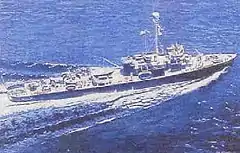
Rear Admiral Lawrence F. Reifsnider in amphibious command ship Panamint
Embarking ![]() III Amphibious Corps (Maj. Gen. Roy S. Geiger, USMC)
III Amphibious Corps (Maj. Gen. Roy S. Geiger, USMC)
- Transport Group "Able" (Task Group 53.1)
- Commodore H.B. Knowles
- Embarking
 6th Marine Division (Maj. Gen. Lemuel C. Shepherd, Jr., USMC)
6th Marine Division (Maj. Gen. Lemuel C. Shepherd, Jr., USMC)
- Transport Division 34
- Transport Division 35
- 5 attack transports: Clay, Leon, George Clymer, Arthur Middleton, Catron
- 2 attack cargos: Caswell, Devosa
- Transport Division 36
- 5 attack transports: Monrovia, Wayne, Sumter, Menifee, Fuller
- 3 attack cargos: Aquarius, Circe, Casa Grande
- 1 vehicle landing ship: Catskill
- Transport Group "Baker" (Task Group 53.2)
- Commodore J. G. Moyer
- Embarking
 1st Marine Division (Maj. Gen. Pedro A. del Valle, USMC)
1st Marine Division (Maj. Gen. Pedro A. del Valle, USMC)
- Transport Division 52
- 8 attack transports: Burleigh, McCracken, Thomas Jefferson, Charles Carroll, Barnett, Andromeda, Cepheus, Oak Hill
- 1 vehicle landing ship: Monitor
- Transport Division 53
- Transport Division 54
- 5 attack transports: Dade, Magoffin, Navarro, Effingham, Joseph T. Dickman
- 3 attack cargos: Betelgeuse, Procyon, White Marsh
- Transport Division 52
- Northern Tractor Flotilla (Task Group 53.3)
- Capt. J. S. Laidlaw
- Tractor Group "Able": 16 LSTs carrying 6 LCTs, 22 pontoon barges and 6 pontoon causeways; 7 LSMs
- Tractor Group "Baker": 16 LSTs carrying 10 LCTs, 16 pontoon barges and 6 pontoon causeways
- Tractor Group "Charlie": 14 LSTs carrying 20 pontoon barges; 8 LSMs
- Northern Control Group: 18 submarine chasers (4 steel hull, 9 wooden hull, 5 sweeper type), Northern Beach Party
- Northern Attack Force Screen (Task Group 53.6)
- Captain J. H. Wellings
_underway_off_Rockland%252C_Maine_(USA)%252C_on_3_July_1943_(80-G-269441).jpg.webp)

- 13 destroyers
- 2 Allen M. Sumner class (6 x 5-in. main battery): Massey, Hugh W. Hadley
- 4 Fletcher class (5 x 5-in. main battery): Pringle,[lower-alpha 3] Hutchins, Stanly, Howorth
- 4 Benham class (4 x 5-in. main battery): Lang, Stack, Sterett, Wilson
- 3 Sims class (5 x 5-in. main battery): Morris, Mustin, Russell
- 5 destroyer escorts
- 4 Buckley class (3 x 3-in. main battery): Gendreau, Fieberling, William C. Cole, Paul G. Baker
- 1 Evarts class (3 x 3-in. main battery): Bebas
- 2 destroyer transports: Charles Lawrence, Roper
- 3 submarine chasers (2 escort type, 1 wooden hull)
- 13 destroyers
- Northern Defense Group (Task Group 53.7)
- Capt. W. W. Weeden
- Embarking Marine Corps support units and high priority cargo: 21 LSTs carrying LCT and pontoon causeways
- 2 oil storage ships: Elk, Camel
- 1 Evarts class (3 x 3-in. main battery) destroyer escort: Fair
- 2 submarine chasers (wooden hull), 7 motor minesweepers
Southern Attack Force (Task Force 55)

_at_anchor_in_San_Francisco_Bay%252C_California_(USA)%252C_in_late_1945_(NH_78541).jpg.webp)
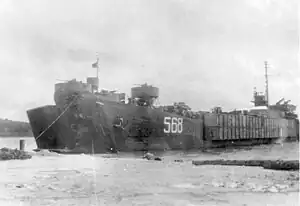
_underway_on_19_August_1944_(NH_107099).jpg.webp)

_underway_in_Delaware_Bay_on_5_September_1943_(NH_83390).jpg.webp)
Rear Admiral John L. Hall in amphibious command ship Teton
Embarking ![]() XXIV Army Corps (Maj. Gen. John R. Hodge)
XXIV Army Corps (Maj. Gen. John R. Hodge)
- Transport Group "Dog" (Task Group 55.1)
- Commodore M.O. Carlson
- Embarking
 7th Infantry ("Bayonet") Division (Maj. Gen. Archibald V. Arnold, USA)
7th Infantry ("Bayonet") Division (Maj. Gen. Archibald V. Arnold, USA)
- Transport Division 37
- Transport Division 38
- 4 attack transports: Barnstable, Elmore, Alpine, Lycoming
- 1 attack cargo: Alshain
- 1 landing ship dock: Epping Forest
- Transport Division 39
- Transport Division 13
- Tractor Group "Dog"
- Tractor Group "Fox"
- Transport Group "Easy" (Task Group 55.2)
- Commodore C.G. Richardson
- Embarking
 96th Infantry ("Deadeye") Division (Maj. Gen. James L. Bradley, USA)
96th Infantry ("Deadeye") Division (Maj. Gen. James L. Bradley, USA)
- Transport Division 40
- 4 attack transports: Mendocino, Sarasota, Haskell, Oconto
- 2 attack cargos: Capricornus, Chara
- 1 landing ship dock: Lindenwald
- Transport Division 41
- Transport Division 42
- 4 attack transports: Neshoba, Oxford, Latimer, Edgecombe
- 1 attack cargo: Virgo
- 1 landing ship dock: Gunston Hall
- Transport Division 14
- 4 attack transports: Allendale, Meriwether, Menard, Kenton
- 1 attack cargo: Achernar
- Tractor Group "Easy": 23 LSTs, 5 LSMs
- Beach Party "Easy", Southern Beach Party
- 15 submarine chasers: 4 steel hull, 7 wooden hull, 4 sweeper type
- 17 LCS(L)s, 6 LSM(R)s
- Transport Division 40
- Screen (Task Group 55.6)
- Captain E.W. Young
- 13 destroyers
- 6 destroyer escorts
- 2 Evarts class (3 x 3-in. main battery): Crouter, Carlson,
- 2 Buckley class (3 x 3-in. main battery): Damon M. Cummings, Vammen
- 1 Cannon class (3 x 3-in. main battery): O'Neill
- 1 John C. Butler class (2 x 5-in. main battery): Walter C. Wann
- 1 destroyer transport
Expeditionary Troops (Task Force 56)

Lieutenant General Simon Bolivar Buckner, Jr., USA (KIA 18 June)
Consisting of ![]() United States Tenth Army
United States Tenth Army
- Northern Landing Area
 III Amphibious Corps (Embarked in Task Force 53)
III Amphibious Corps (Embarked in Task Force 53)- Maj. Gen. Roy S. Geiger, USMC
- Left beaches: 6th Marine Division (Maj. Gen. Lemuel C. Shepherd, Jr., USMC)
- Right beaches: 1st Marine Division (Maj. Gen. Pedro A. del Valle, USMC)
- Southern Landing Area
 XXIV Army Corps (Embarked in Task Force 55)
XXIV Army Corps (Embarked in Task Force 55)- Maj. Gen. John R. Hodge, USA
- Left beaches: 7th Infantry ("Bayonet") Division (Maj. Gen. Archibald V. Arnold, USA)
- Right beaches: 96th Infantry ("Deadeye") Division (Maj. Gen. James L. Bradley, USA)
- Landed L+8: 27th Infantry ("New York") Division (Maj. Gen. George W. Griner, Jr., USA)
- Western Islands
- Landed L+26: 77th Infantry ("Statue of Liberty") Division and one Marine BLT (Maj. Gen. Andrew D. Bruce, USA)
Allied combat ships
Amphibious Support Forces (Task Force 52)
.jpg.webp)

Rear Admiral William H.P. Blandy in amphibious command ship Estes

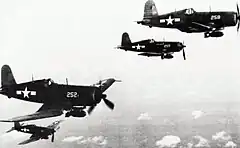

- Support Carrier Group (Task Group 52.1)
- Rear Admiral Calvin T. Durgin
- Unit One
- Rear Admiral Clifton A.F. Sprague
- 7 escort carriers
- Makin Island (Capts. W.B. Whaley and I.E. Hobbs)
- VC-84 (Lt. D.K. English, USNR), 27 aircraft
- 16 FM-2 Wildcat fighters
- 11 TBM Avenger torpedo bombers
- Fanshaw Bay (Capt. M.E. Arnold)
- VOC-2 (Lt. Cmdr. R.M. Allison), 30 aircraft
- 24 FM-2 Wildcat fighters
- 6 TBM Avenger torpedo bombers
- Lunga Point (Capt. G.A.T. Washburn)
- VC-85 (Lt. Cmdr. F.C. Herriman), 30 aircraft
- 18 FM-2 Wildcat fighters
- 12 TBM Avenger torpedo bombers
- Sangamon (Capts. M.E. Browder and A.I. Malstrom)
- Air Group 33 (Cmdr. F.B. Gilkeson), 30 aircraft
- 24 F6F Hellcat fighters
- 6 TBM Avenger torpedo bombers
- Natoma Bay (Capts. Albert K. Morehouse and B.B. Nichol)
- VC-81 (Lt. Cmdr. W.B. Morton, USNR), 32 aircraft
- 20 FM-2 Wildcat fighters
- 12 TBM Avenger torpedo bombers
- Savo Island (Capt. W.D. Anderson)
- VC-91 (Lt. F.M. Blanchard, USNR), 35 aircraft
- 20 FM-2 Wildcat fighters
- 15 TBM Avenger torpedo bombers
- Anzio (Capt. G.C. Montgomery)
- VC-13 (Lt. Cmdr. R.P. Williams, USNR), 24 aircraft
- 12 FM-2 Wildcat fighters
- 12 TBM Avenger torpedo bombers
- Makin Island (Capts. W.B. Whaley and I.E. Hobbs)
- Screen (Commander J.C. Zahm)
- 6 destroyers
- 1 Allen M. Sumner class (6 x 5-in. main battery): Ingraham
- 3 Fletcher class (5 x 5-in. main battery): Boyd, Bradford, Hart
- 2 Bagley class (4 x 5-in. main battery): Bagley, Patterson
- 11 destroyer escorts
- 9 John C. Butler class (2 x 5-in. main battery): Lawrence C. Taylor, Melvin R. Nawman, Oliver Mitchell, Robert F. Keller, Tabberer, Richard M. Rowell, Richard S. Bull, Dennis, O'Flaherty
- 2 Evarts class (3 x 3-in. main battery): Sederstrom, Fleming
- 6 destroyers
- 7 escort carriers
- Unit Two


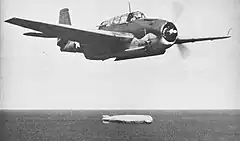
_underway_on_17_July_1944_(BS_68165).jpg.webp)
- Rear Admiral Felix B. Stump
- 7 escort carriers
- Saginaw Bay (Capts. F.C. Sutton and Robert Goldwaite)
- VC-88 (Lt. E.L. Kemp, USNR), 32 aircraft
- 20 FM-2 Wildcat fighters
- 12 TBM Avenger torpedo bombers
- Sargent Bay (Capt. R.M. Oliver)
- VC-83 (Lt. Cmdr. B.V. Gates (KIA) and Lt. M.S. Worley, USNR), 28 aircraft
- 16 FM-2 Wildcat fighters
- 12 TBM Avenger torpedo bombers
- Rudyerd Bay (Capts. C.S. Smiley and J.G. Foster)
- VC-96 (Lt. Cmdr. W.S. Woollen, USNR), 31 aircraft
- 20 FM-2 Wildcat fighters
- 11 TBM Avenger torpedo bombers
- Marcus Island (Capt. H.V. Hopkins)
- VC-87 (Lt. H.N. Heisel), 32 aircraft
- 20 FM-2 Wildcat fighters
- 12 TBM Avenger torpedo bombers
- Petrof Bay (Capt. R.S. Clarke)
- VC-93 (Lt. Cmdr. C.P. Smith), 28 aircraft
- 16 FM-2 Wildcat fighters
- 12 TBM Avenger torpedo bombers
- Tulagi (Capts. J.C. Cronin & W.V. Davis)
- VC-92 (Lt. Cmdr. J.B. Wallace), 31 aircraft
- 19 FM-2 Wildcat fighters
- 12 TBM Avenger torpedo bombers
- Wake Island (Capt. A.V. Magly)
- VOC-1 (Lt. Cmdr. W.F. Bringie), 32 aircraft
- 26 FM-2 Wildcat fighters
- 6 TBM Avenger torpedo bombers
- Saginaw Bay (Capts. F.C. Sutton and Robert Goldwaite)
- Screen (Captain G.P. Hunter)
- 4 destroyers
- 1 Allen M. Sumner class (6 x 5-in. main battery): Lowry
- 3 Fletcher class (5 x 5-in. main battery): Capps, Evans, John D. Henley
- 6 destroyer escorts
- 4 John C. Butler class (2 x 5-in. main battery): William Seiverling, Ulvert M. Moore (Lt. Cmdr. Franklin D. Roosevelt Jr., USNR), Kendall C. Campbell, Goss
- 2 Evarts class (3 x 3-in. main battery): Tisdale, Eisele
- 4 destroyers
- 7 escort carriers
- Rear Admiral Felix B. Stump
- Unit Three

_at_anchor_at_Kwajalein_atoll_on_7_February_1944_(NH_106578).jpg.webp)
- Rear Admiral William D. Sample
- 4 escort carriers
- Suwannee (Capt. D.S. Cornwell)
- Air Group 40 (Lt. Cmdr. R.D. Sampson (KIA) and Lt. Cmdr. J.C. Longino), 27 aircraft
- 17 F6F Hellcat fighters
- 10 TBM Avenger torpedo bombers
- Chenango (Capts. George van Deurs and Harry D. Felt)
- Air Group 25 (Lt. Cmdr. R.W. Robinson (KIA), Lt. B. Phillips and Lt. Cmdr. P.M. Paul), 30 aircraft
- 18 F6F Hellcat fighters
- 12 TBM Avenger torpedo bombers
- Santee (Capt. J.V. Peterson)
- Air Group 24 (Lt. Cmdr. R.J. Ostrom (KIA) and Lt. P.N. Charbonnet), 30 aircraft
- 18 F6F Hellcat fighters
- 12 TBM Avenger torpedo bombers
- Steamer Bay (Capt. J.B. Paschal)
- VC-90 (Lt. Cmdr. R.A. O'Neill), 31 aircraft
- 19 FM-2 Wildcat fighters
- 12 TBM Avenger torpedo bombers
- Suwannee (Capt. D.S. Cornwell)
- Screen (Captain Alvin Duke Chandler)
- 5 destroyers
- 1 Allen M. Sumner class (6 x 5-in. main battery): Drexler
- 3 Fletcher class (5 x 5-in. main battery): Metcalf, Fullam, Guest
- 1 Bagley class (4 x 5-in. main battery): Helm
- 2 destroyer escorts
- 2 John C. Butler class (2 x 5-in. main battery): John C. Butler, Edmonds
- 5 destroyers
- 4 escort carriers
- Rear Admiral William D. Sample
- Special Escort Carrier Group
%252C_in_1944.jpg.webp)
- Captain C.L. Lee (arriving 4 April)
- 4 escort carriers
- Hollandia (Capt. Lee)
- White Plains (Capt. D.J. Sullivan and Frederick Funke)
- Sitkoh Bay (Capts. R.G. Lockhart and J.P. Walker)
- Breton (Capt. Frank Obeirne)
- Marine Air Group 31 (Col. John C. Munn, USMC)
- Marine Air Group 33 (Col. W. E. Dickey, USMC)
- 192 F4U Corsair and 30 F6F Hellcat fighters to operate from Okinawa airfields
- Screen (Commander R.A. Wilhelm, USNR)
- 4 destroyer transports: Kilty, Manley, George E. Badger, Greene
- 4 escort carriers
- Captain C.L. Lee (arriving 4 April)
- Mine Flotilla (Task Group 52.2)

.jpg.webp)

.jpg.webp)
- Rear Admiral Alexander Sharp and Captain R. P. Whitemarsh in Terror
- Destroyer Minesweeper Group (Task Group 52.3)
- Capt. R.A. Larkin
- Minesweeper Group One (Task Group 52.4)
- Captain T.F. Donohue
- 18 Auk-class minesweepers: Champion, Heed, Defense, Devastator, Ardent, Requisite, Revenge, Pursuit, Sage, Sheldrake, Skylark,[lower-alpha 5] Starling, Swallow,[lower-alpha 6] Gladiator, Impeccable, Spear, Triumph, Vigilance
- 4 fast minelayers (ex-destroyers): Adams, Tolman, Henry A. Wiley, Shea
- 3 submarine chasers (steel hull): PC-1128, PC-1179, PC-1598
- Minesweeper Group Two (Task Group 52.5)
- Captain L. F. Freiburghouse
- 18 Admirable-class minesweepers: Skirmish, Staunch, Signet, Scurry, Spectacle, Spector, Superior, Serene, Shelter, Strategy, Strength, Success, Ransom, Diploma, Density, Facility, Rebel, Recruit
- 2 fast minelayers (ex-destroyers): Tracy, J. William Ditter
- 3 motor gunboats (steel hull): PGM-9, PGM-10, PGM-11
- Reserve Sweep Group (Task Group 52.7)
- Cmdrs. E.D. McEathron and J.W. Wyckoff
- 6 Admirable-class minesweepers: Buoyant, Gayety, Design, Device, Hazard, Execute
- Reinforced by the following in May:
- 14 motor minesweepers
- 4 destroyer transports with sweep gear-equipped landing craft personnel, ramped (LCP(R)s) embarked: Reeves, Daniel T. Griffin, Waters, Sims
- 2 minelayers: Weehawken, Monadnock
- 1 repair ship: Mona Island
- Net and Buoy Group (Task Group 52.8)
- Cmdr. G. C. King, USNR
- 9 Ailanthus-class net laying ships: Snowbell, Terebinth, Corkwood, Spicewood, Cliffrose, Stagbush, Abele, Winterberry, Pinon
- 3 Aloe-class net laying ships: Mahogany, Aloe, Chinquapin
- 1 mine and net laying ship: Keokuk
- 2 net cargo ships: Sagittarius, Tuscana
Gunfire and Covering Force (Task Force 54)
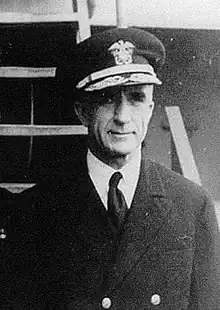
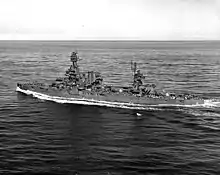
_firing_broadside_c1944.png.webp)
Rear Admiral Morton L. Deyo in battleship Tennessee
- Unit One (Rear Admiral Peter K. Fischler)
- 2 battleships: Texas, Maryland
- 1 heavy cruiser: Tuscaloosa
- 4 Fletcher-class destroyers: Laws, Longshaw, Morrison, Prichett
- Unit Two (Rear Admiral C. Turner Joy)
- 2 battleships: Arkansas, Colorado
- 2 heavy cruisers: San Francisco, Minneapolis
- 3 Fletcher-class destroyers: Halligan,[lower-alpha 7] Paul Hamilton, Twiggs[lower-alpha 8]
- 1 Allen M. Sumner-class destroyer: Laffey
- Unit Three (Rear Admiral Bertram J. Rodgers)
- 2 battleships: Tennessee, Nevada
- 1 heavy cruiser: Wichita
- 2 light cruisers: Birmingham, St. Louis
- 4 Allen M. Sumner-class destroyers: Mannert L. Abele,[lower-alpha 9] Zellars, Barton, O'Brien
- 1 Fletcher-class destroyer: Bryant
- Unit Four (Rear Admiral Lynde D. McCormick)
- 2 battleships: Idaho, West Virginia
- 2 heavy cruisers: Pensacola, Portland
- 1 light cruiser: Biloxi
- 5 Fletcher-class destroyers: Porterfield, Callaghan,[lower-alpha 10] Irwin, Cassin Young, Preston
- Unit Five (Rear Admiral Allan E. Smith)
- Battleship Division 3 (George L. Weyler): 2 battleships: New Mexico, New York
- Cruiser Division 5 (Allan E. Smith): 2 heavy cruisers: Salt Lake City, Indianapolis
- Destroyer Squadron 56 (Roland N. Smoot): 5 Fletcher-class destroyers: Newcomb, Heywood L. Edwards, Richard P. Leary, Bennion, Leutze
- Unit Six (Commander W.B. Hinds, USNR)
- 2 Cannon-class destroyer escorts: Samuel S. Miles, Wesson
- 6 Buckley-class destroyer escorts: Foreman, Whitehurst, England, Witter, Bowers, Willmarth
- Reported to TF 54 after L-day
- 1 battleship: Mississippi
- 1 heavy cruiser: New Orleans
- 1 Fletcher-class destroyer: Daly
- 1 fast minesweeper: Forrest
British Carrier Force (Task Force 57)






Vice Admiral Sir Bernard Rawlings, RN
- First Aircraft Carrier Squadron (Task Group 57.2)
- Rear Admiral Sir Philip L. Vian, RN
- 5 fleet carriers
- HMS Indomitable (Capt. J.A.S. Eccles, RN), 44 aircraft
- 29 F6F Hellcat fighters
- 15 TBF Avenger torpedo bombers
- HMS Victorious (Capt. M.M. Denny, RN), 53 aircraft
- 37 F4U Corsair fighters
- 14 TBF Avenger torpedo bombers
- 2 Supermarine Walrus scout planes
- HMS Illustrious (Capt. C.E. Lambe, RN), 52 aircraft
- 36 F4U Corsair fighters
- 16 TBF Avenger torpedo bombers
- HMS Indefatigable (Capt. Q.D. Graham, RN), 69 aircraft
- 40 Supermarine Seafire fighters
- 20 TBF Avenger torpedo bombers
- 9 Fairey Firefly fighters
- HMS Formidable (Capt. P. Ruck-Keene, RN), 43 aircraft
- 28 F4U Corsair fighters
- 15 TBF Avenger torpedo bombers
- HMS Indomitable (Capt. J.A.S. Eccles, RN), 44 aircraft
- 5 fleet carriers
- First Battle Squadron (Task Group 57.1)
- Vice Admiral Rawlings
- 2 battleships
- HMS King George V (10 x 14 in. main battery)
- HMS Howe (10 x 14 in. main battery)
- 2 battleships
- Fourth Cruiser Squadron (Task Group 57.4)
- Rear Admiral E.J.P. Brind
- 7 light cruisers
- 2 Crown Colony class: HMNZS Gambia (12 x 6 in. main battery), HMCS Uganda (9 x 6 in. main battery)
- 1 Minotaur class: HMS Swiftsure (12 x 6 in. main battery)
- 1 Leander class: HMNZS Achilles (6 x 6 in. main battery)
- 3 Dido class: HMS Argonaut (8 x 5.25 in. main battery), HMS Euryalus (10 x 5.25 in. main battery), HMS Black Prince (10 x 5.25 in. main battery)
- 7 light cruisers
- Screen (Task Group 57.8)
- Rear Admiral J.H. Edelston
- 4th Destroyer Flotilla
- 24th Destroyer Flotilla
- 25th Destroyer Flotilla
- 27th Destroyer Flotilla
- British Fleet Train (Task Force 112)
- Rear Admiral D.B. Fisher, RN
- 70+ auxiliaries including repair ships, oilers, minesweepers, hospital ships, etc.
Fast Carrier Force (Task Force 58)
.jpg.webp)
.jpg.webp)
Vice Admiral Marc A. Mitscher in fleet carrier Bunker Hill
- Task Group 58.1
_underway_at_sea_on_20_October_1944.jpg.webp)
_off_Norfolk%252C_Virginia_(USA)%252C_on_3_June_1942_(19-N-31525).jpg.webp)
_refueling_Feb_1945.jpg.webp)
- Rear Admiral Joseph J. Clark
- 3 fleet carriers
- Hornet (Capt. Austin K. Doyle)
- Air Group 17 (Cmdr. E.G. Konrad), 101 aircraft
- VF-17: 71 F6F Hellcat fighters
- VB-17: 15 SB2C Helldiver dive bombers
- VT-17: 15 TBM Avenger torpedo bombers
- Air Group 17 (Cmdr. E.G. Konrad), 101 aircraft
- Wasp (Capts. O.A. Weller and W.G. Switzer)
- Air Group 86 (Cmdr. G.R. Luker), 100 aircraft
- VBF-86: 36 F4U Corsair fighters
- VF-86: 34 F6F Hellcat fighters
- VB-86: 15 SB2C Helldiver dive bombers
- VT-86: 15 TBM Avenger torpedo bombers
- Air Group 86 (Cmdr. G.R. Luker), 100 aircraft
- Bennington (Capts. J.B. Sykes and B.L. Braun)
- Air Group 82 (Cmdr. G.L. Heap), 92 aircraft
- VF-82: 37 F6F Hellcat fighters
- VB-82: 15 SB2C Helldiver dive bombers
- VT-82: 15 TBM Avenger torpedo bombers
- VMF-112: 18 F4U Corsair fighters
- VMF-123: 17 F4U Corsair fighters
- Air Group 82 (Cmdr. G.L. Heap), 92 aircraft
- Hornet (Capt. Austin K. Doyle)
- 3 fleet carriers
- 2 light carriers
- Belleau Wood (Capts. John Perry and W.G. Tomlinson)
- Air Group 30 (Lt. Cmdr. D.A. Clark), 34 aircraft
- VF-30: 25 F6F Hellcat fighters
- VT-30: 9 TBM Avenger torpedo bombers
- Air Group 30 (Lt. Cmdr. D.A. Clark), 34 aircraft
- San Jacinto (Capt. M.H. Kernodle)
- Air Group 45 (Cmdr. G.E. Schecter), 34 aircraft
- VF-45: 25 F6F Hellcat fighters
- VT-45: 9 TBM Avenger torpedo bombers
- Air Group 45 (Cmdr. G.E. Schecter), 34 aircraft
- Belleau Wood (Capts. John Perry and W.G. Tomlinson)
- 2 light carriers
- Battleship Division 8 (Rear Admiral John F. Shafroth Jr.)
- 3 fast battleships
- South Dakota (Capts. C.F. Stillman and Charles B. Momsen) - flagship
- Massachusetts (Capts. W.W. Warlick and John R. Redman)
- Indiana (Capts. T.J. Keliher and Francis P. Old)
- 3 fast battleships
- Battleship Division 8 (Rear Admiral John F. Shafroth Jr.)
- Cruiser Division 10 (Rear Admiral Lloyd J. Wiltse)
- 2 heavy cruisers
- Baltimore (Capt. C.K. Fink)
- Pittsburgh (Capt. John E. Gingrich)
- 2 heavy cruisers
- Cruiser Division 10 (Rear Admiral Lloyd J. Wiltse)
- Cruiser Division 14 (Rear Admiral Francis E. M. Whiting)
- 3 light cruisers
- 1 anti-aircraft light cruiser[lower-alpha 11]
- San Juan (Capts. J.F. Donovan and G.H. Bahm)
- Cruiser Division 14 (Rear Admiral Francis E. M. Whiting)
- Screen
- 21 destroyers
- 9 Allen M. Sumner class (6 x 5-in. main battery): Dehaven, Mansfield, Lyman K. Swenson, Collett, Maddox,[lower-alpha 12] Blue, Brush, Taussig, Samuel N. Moore
- 12 Fletcher class (5 x 5-in. main battery): Wedderburn, Twining, Stockham, John Rodgers, Stevens, Harrison, McKee, Murray, Sigsbee, Ringgold, Schroeder, Dashiell
- 21 destroyers
- Screen
- Task Group 58.2

.jpg.webp)
_off_New_York%252C_1942.jpg.webp)
- Rear Admirals Ralph E. Davison and Gerald F. Bogan
- 3 fleet carriers
- Enterprise (Capt. Grover B. H. Hall)
- Night Air Group 90 (Cmdr. W.I. Martin), 53 aircraft
- VFN-90: 32 F6F Hellcat fighters
- VTN-90: 21 TBM Avenger torpedo bombers
- Night Air Group 90 (Cmdr. W.I. Martin), 53 aircraft
- Franklin (Capt. Leslie E. Gehres)
- Air Group 5 (Cmdr. E.B. Parker Jr.),[2][3] 107 aircraft
- VF-5: 19 F6F Hellcat fighters
- VB-5: 8 SB2C Helldiver, 11 SBW Helldiver dive bombers
- VT-5: 6 TBF Avenger, 10 TBM Avenger torpedo bombers
- VMF-214: 18 F4U Corsair fighters[4]
- VMF-452: 18 F4U Corsair fighters
- Air Group 5 (Cmdr. E.B. Parker Jr.),[2][3] 107 aircraft
- Randolph (Capt. F.L. Baker)
- Air Group 12 (Cmdrs. C.L. Crommelin (KIA), E.J. Pawka, USNR), 97 aircraft
- VF-12: 33 F6F Hellcat fighters
- VBF-12: 24 F6F Hellcat fighters
- VB-12: 15 SB2C Helldiver dive bombers
- VT-12: 15 TBM Avenger torpedo bombers
- Air Group 12 (Cmdrs. C.L. Crommelin (KIA), E.J. Pawka, USNR), 97 aircraft
- Enterprise (Capt. Grover B. H. Hall)
- 3 fleet carriers
- 1 light cruiser
- Santa Fe (Capt. H.C. Fitz)
- 1 light cruiser
- Screen
- 8 Fletcher-class destroyers (5 x 5-in. main battery): Miller, Owen, Hickox, Hunt, Lewis Hancock, Marshall, Stephen Potter, Tingey
- Screen
- Task Group 58.3
_underway_at_sea%252C_26_July_1945_(80-G-262768).jpg.webp)
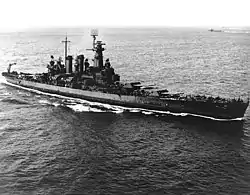
_off_the_Mare_Island_Naval_Shipyard_on_10_July_1945_(19-N-86911).jpg.webp)
- Rear Admiral Frederick C. Sherman
- 3 fleet carriers
- Essex (Capt. C.W. Wieber)
- Air Group 83 (Cmdr. Harmon Tischer Utter), 102 aircraft
- VF-83: 36 F6F Hellcat fighters
- VBF-83: 36 F4U Corsair fighters
- VB-83: 15 SB2C Helldiver dive bombers
- VT-83: 15 TBM Avenger torpedo bombers
- Air Group 83 (Cmdr. Harmon Tischer Utter), 102 aircraft
- Bunker Hill (Capt. G.A Seitz)
- Air Group 84 (Cmdr. G.M. Ottinger), 93 aircraft
- VF-84: 27 F4U Corsair fighters, 10 F6F Hellcat fighters
- VB-84: 15 SB2C Helldiver dive bombers
- VT-84: 15 TBM Avenger torpedo bombers
- VMF-221: 18 F4U Corsair fighters
- VMF-451: 18 F4U Corsair fighters
- Air Group 84 (Cmdr. G.M. Ottinger), 93 aircraft
- Hancock (Capt. R.F. Hickey)
- Air Group 6 (Cmdr. H.L. Miller), 94 aircraft
- VF-6: 36 F6F Hellcat fighters
- VBF-6: 36 F6F Hellcat fighters
- VB-6: 12 SB2C Helldiver dive bombers
- VT-6: 10 TBM Avenger torpedo bombers
- Air Group 6 (Cmdr. H.L. Miller), 94 aircraft
- Essex (Capt. C.W. Wieber)
- 3 fleet carriers
- 2 light carriers
- Cabot (Capt. W.W. Smith)
- Air Group 29 (Lt. Cmdr. W.E. Eder), 33 aircraft
- VF-29: 24 F6F Hellcat fighters
- VT-29: 9 TBM Avenger torpedo bombers
- Air Group 29 (Lt. Cmdr. W.E. Eder), 33 aircraft
- Bataan (Capt. J.B. Heath)
- Air Group 47 (Cmdr. Walker Etheridge and Lt. Cmdr. A.H. Clancy), 36 aircraft
- VF-47: 24 F6F Hellcat fighters
- VT-47: 12 TBM Avenger torpedo bombers
- Air Group 47 (Cmdr. Walker Etheridge and Lt. Cmdr. A.H. Clancy), 36 aircraft
- Cabot (Capt. W.W. Smith)
- 2 light carriers
- Battleship Division 6 (Rear Admiral Thomas R. Cooley)
- 2 fast battleships
- North Carolina (Capts. Oswald S. Colclough and Byron H. Hanlon)
- Washington (Capts. Roscoe F. Good and Francis X. McInerney)
- 2 fast battleships
- Battleship Division 6 (Rear Admiral Thomas R. Cooley)
- Cruiser Division 17 (Rear Admiral J. Cary Jones)
- 1 heavy cruiser
- Indianapolis (Capt. C.B. McVay)
- 4 light cruisers
- Pasadena (Capts. R.B. Tuggle and James H. Doyle)
- Springfield (Capts. F.L. Johnson and T.J. Kelley)
- Astoria (Capts. George C. Dyer and W.V. Hamilton)
- Wilkes-Barre (Capt. R.L. Porter)
- 1 heavy cruiser
- Cruiser Division 17 (Rear Admiral J. Cary Jones)
- Screen
- 17 destroyers
- 9 Allen M. Sumner class (6 x 5-in. main battery): Ault, English, Charles S. Sperry, Waldron, Haynsworth, Wallace L. Lind, John W. Weeks, Hank, Borie
- 8 Fletcher class (5 x 5-in. main battery): Erben, Walker, Hale, Stembel, Black, Bullard, Kidd, Chauncey
- 17 destroyers
- Screen
- Task Group 58.4

_underway_off_Newport_News_on_16_August_1943_(NH_53254).jpg.webp)

_at_anchor%252C_in_1944.gif)
- Rear Admiral Arthur W. Radford
- 2 fleet carriers
- Yorktown (Capts. T.S. Combs and Walter F. Boone)
- Air Group 9 (Cmdr. P.H. Torrey and Lt. Cmdr. H.N. Houck, USNR), 95 aircraft
- VF-9: 40 F6F Hellcat fighters
- VBF-9: 33 F6F Hellcat fighters
- VB-9: 15 SB2C Helldiver dive bombers
- VT-9: 7 TBM Avenger torpedo bombers
- Air Group 9 (Cmdr. P.H. Torrey and Lt. Cmdr. H.N. Houck, USNR), 95 aircraft
- Intrepid (Capt. G.E. Short)
- Air Group 10 (Cmdr. J.J. Hyland), 96 aircraft
- VF-10: 30 F4U Corsair, 6 F6F Hellcat fighters
- VBF-10: 36 F4U Corsair fighters
- VB-10: 15 SB2C Helldiver dive bombers
- VT-10: 15 TBF Avenger torpedo bombers
- Air Group 10 (Cmdr. J.J. Hyland), 96 aircraft
- Yorktown (Capts. T.S. Combs and Walter F. Boone)
- 2 light carriers
- Langley (Capt. J.F. Wegforth)
- Air Group 23 (Lt. Cmdr. Merlin Paddock, USNR (KIA) and Cmdr. J.J. Southerland), 34 aircraft
- VF-23: 25 F6F Hellcat fighters
- VT-23: 9 TBM Avenger torpedo bombers
- Air Group 23 (Lt. Cmdr. Merlin Paddock, USNR (KIA) and Cmdr. J.J. Southerland), 34 aircraft
- Independence (Capt. N.M. Kindell)
- Air Group 46 (Cmdr. C.W. Rooney), 33 aircraft
- VF-46: 25 F6F Hellcat fighters
- VT-46: 8 TBM Avenger torpedo bombers
- Air Group 46 (Cmdr. C.W. Rooney), 33 aircraft
- Langley (Capt. J.F. Wegforth)
- 2 fleet carriers
- Battleship Division 9 (Rear Admiral Edward W. Hanson and Louis E. Denfeld)
- 3 fast battleships
- Wisconsin (Capt. Earl E. Stone and John W. Roper)
- Missouri (Capts. W.M. Callaghan and Stuart S. Murray)
- New Jersey (Capt. Edmund T. Wooldridge)
- 3 fast battleships
- Battleship Division 9 (Rear Admiral Edward W. Hanson and Louis E. Denfeld)
- Cruiser Division 16 (Rear Admiral Francis S. Low)
Allied logistics and support vessels
Support and Service Units (Task Force 50)
_at_Apia%252C_Samoa%252C_on_20_April_1943_(80-G-K-6985).jpg.webp)

_at_sea_circa_in_November_1943.jpg.webp)
.jpg.webp)
_underway_in_San_Pedro_Bay%252C_California_(USA)%252C_15_August_1944_(NH_103222).jpg.webp)
_09031606_(crop).jpg.webp)
- Search and Reconnaissance Group (Task Group 50.5)
- Commodore Dixwell Ketcham
- 3 seaplane tenders
- Hamlin (Capt. G.A. McLean)
- VPB-208 (Lt. Cmdr. A.J. Sintic, USNR)
- 12 Martin PBM Mariner patrol bomber flying boats
- St. George (Capt. R.G. Armstrong)
- VPB-18 (Lt. Cmdr. R.R. Boettcher)
- 12 Martin PBM Mariner patrol bomber flying boats
- Chandeleur (Cmdr. J.S. Tracy)
- VPB-21 (Lt. Cmdrs. J.E. Dougherty & J.D. Wright)
- 12 Martin PBM Mariner patrol bomber flying boats
- Hamlin (Capt. G.A. McLean)
- 3 small seaplane tenders
- Yakutat (Cmdr. G.K. Fraser)
- Onslow (Cmdr. A.D. Schwarz)
- Shelikof (Cmdr. R.E. Stanley)
- VPB-27 (Lt. Cmdr. E.N. Chase)
- 12 Martin PBM Mariner patrol bomber flying boats
- Bering Strait (Cmdr. W.D. Innis)
- VH-3 (Lt. Cmdr. W.D. Bonvillian)
- 6 Martin PBM Mariner patrol bomber flying boats
- 2 destroyer seaplane tenders: Thornton,[lower-alpha 13] Gillis
- 1 Clemson-class destroyer: Williamson
- 3 seaplane tenders
- Logistics Support Group Fifth Fleet (Task Group 50.8)
- Rear Admiral Donald B. Beary in light cruiser Detroit
- Support escort carriers
- Shamrock Bay (Capts. F.T. Ward and J.E. Leeper)
- VC-94 (Lt. Cmdr. J.F. Patterson, USNR (KIA) and Lt. L.E. Terry)
- 18 FM-2 Wildcat fighters
- 12 TBM Avenger torpedo bombers
- Makassar Strait (Capt. Herbert D. Riley)
- VC-97 (Lt. Cmdr. M.T. Whittier, USNR)
- 14 FM-2 Wildcat fighters
- 12 TBM Avenger torpedo bombers
- Shamrock Bay (Capts. F.T. Ward and J.E. Leeper)
- CVE Plane Transport Unit (Task Unit 50.8.4)
- Attu (Capt. H.F. MacComsey)
- Admiralty Islands (Capt. M.E.A. Gouin)
- Bougainville (Capt. C.A. Bond)
- Windham Bay (Capt. G.T. Mundorff)
- Logistics and Support Vessels
- 49 oilers: Cuyama, Brazos, Cimarron, Platte, Sabine, Kaskaskia, Guadalupe, Chicopee, Housatonic, Merrimack, Kankakee, Lackawanna, Monongahela, Tappahannock, Patuxent, Neches, Suamico, Tallulah, Ashtabula, Cacapon, Caliente, Chikaskia, Aucilla, Marias, Manatee, Nantahala, Severn, Taluga, Chipola, Tolovana, Pecos, Atascosa, Cache, Enoree, Escalante, Neshanic, Niobrara, Millicoma, Saranac, Cossatot, Cowanesque, Escambia, Cahaba, Mascoma, Ocklawaha, Ponaganset, Sebec, Tomahawk, Anacostia
- 16 ammunition ships: Akutan, Firedrake, Lassen, Mauna Loa, Shasta, Vesuvius, Wrangell, Canada Victory,[lower-alpha 14] Bedford Victory, Bucyrus Victory, Manderson Victory, Las Vegas Victory, Logan Victory,[lower-alpha 14] Greenburg Victory, Pierre Victory, Hobbs Victory[lower-alpha 14]
- 9 cargo ships: Adhara, Alkaid, Alkes, Allegan, Appanoose, Fomalhaut, Matar, Mintaka, Rotanin
- 8 hospital ships: Bountiful, Comfort, Hope, Mercy, Relief, Samaritan, Solace, plus transport Wharton
- 6 reefers (store ships): Adria, Athanasia, Bridge, Latona, Lioba, Merapi
- 2 survey ships: Armistead Rust, Bowditch
- 2 stores-issue ships: Antares, Castor
- 9 gasoline tankers: Wabash, Genesee, Kishwaukee, Nemasket, Escatawpa, Hiwassee, Ontonagon, Yahara, Ponchatoula, Sacandaga
- 6 station tankers: Armadillo, Giraffe, Marmora, Moose, Whippet, LCI(L)-993
- 10 repair ships: Vestal, Aristaeus, Nestor, Oceanus, Anchor, Clamp, Current, Deliver, Gear, Shackle
- 6 floating drydocks: ARD-13, ARD-22, ARD-27, ARD-28, AFD-14, AFDL-32
- 12 fleet tugs: Arikara, Chickasaw, Cree, Lipan, Mataco, Menominee, Munsee, Pakana, Tawakoni, Tekesta, Tenino, Ute
- 4 ocean tugs, 3 ocean tugs (rescue)
- Screen: Screening vessels for the Logistics Group were assigned to TG 50.8 units as needed from a pool of 11 destroyers and 24 destroyer escorts.
- Support escort carriers
Japanese order of battle
Japanese Combined Fleet[5]
Admiral Soemu Toyoda
.jpg.webp)
Surface Special Attack Force
Vice Admiral Seiichi Ito (KIA)
- Super battleship: Yamato[lower-alpha 15]
- Captain Kosaku Aruga (KIA)
- Destroyer Squadron 2 (Rear Admiral Keizo Komura)
- Light cruiser: Yahagi[lower-alpha 15] (Captain Tameichi Hara)
- Destroyer Division 41 (Capt. M. Yoshida): Fuyutsuki, Suzutsuki
- Destroyer Division 17 (Capt. K. Shintani – KIA): Isokaze,[lower-alpha 16] Hamakaze,[lower-alpha 15] Yukikaze
- Destroyer Division 21 (Capt. H. Kotaki – KIA): Asashimo,[lower-alpha 16] Kasumi,[lower-alpha 16] Hatsushimo
Naval vessels damaged and sunk at Okinawa
The following table lists the Allied naval vessels that received damage or were sunk in the Battle of Okinawa between 19 March – 30 July 1945. The table lists a total of 147 damaged ships, five of which were damaged by enemy suicide boats, and another five by mines. One source estimated that total Japanese sorties during the entire Okinawa campaign exceeded 3,700, with a large percentage kamikaze, and that the attackers damaged slightly more than 200 Allied vessels, with 4900 naval officers and seamen killed and roughly 4,824 wounded or missing.[6][7] The USS Thorton is not listed as it was damaged as the result of a collision with another US ship. Those ships in a pink background, and with an asterisk were sunk or had to be scuttled due to irreparable damage. Of those sunk, the majority were relatively smaller ships; these included destroyers of around 300–450 feet. A few small cargo ships were also sunk, several containing munitions which caught fire. Those ships whose names are preceded by a "#" pound sign were scrapped or decommissioned as a result of damage.
Notes
- ↑ Sunk by kamikaze 10 June
- ↑ Scuttled 4 April following severe damage from kamikaze on 2 April
- ↑ Sunk by kamikaze 16 April
- 1 2 Sunk by kamikaze 6 April
- ↑ Struck mine 28 April
- ↑ Sunk by kamikaze 22 April
- ↑ Struck mine 26 March
- ↑ Sunk by kamikaze 16 June
- ↑ Sunk by kamikaze 12 April
- ↑ Sunk by kamikaze 28 July
- 1 2 These cruisers were intended as destroyer leaders when designed. After the first two to be used in this role, Atlanta and Juneau, were lost at the Naval Battle of Guadalcanal, this mission was rejected and the anti-aircraft mission adopted.[1]
- ↑ About 19 years after Okinawa, the Maddox was involved in the Tonkin Gulf Incident that served as a pretext for the escalation of US combat forces in Vietnam.
- ↑ Sunk after collision 5 April
- 1 2 3 Sunk by kamikaze
- 1 2 3 Sunk by US carrier planes 7 April
- 1 2 3 Scuttled after receiving severe damage from US carrier planes 7 April
References
- ↑ Stille, p. 7
- ↑ O'Callahan, Joseph T. (1956). I Was Chaplain on the Franklin. New York: The Macmillan Company. p. 40. LCCN 56010786.
- ↑ Foster, Jeremiah D. (November 21, 2019). "Franklin III (CV-13)". Naval History and Heritage Command. Retrieved July 2, 2020.
- ↑ Condon, John P. "U.S. Marine Corps Aviation". Deputy Chief of Naval Operations (Air Warfare) and Commander, Naval Air Systems Command. p. 21. Retrieved July 2, 2020.
- ↑ Morison, p. 202
- ↑ Toll, Ian, Twilight of the Gods, (2020) Norton and Co., New York, New York, pg. 593
- ↑ "The British Fleet at Okinawa". The British Fleet at Okinawa. WWII Forums. Retrieved November 4, 2020.
- ↑ All information is public domain from United States Navy, with casualties taken from individual action reports, table format and structure is heavily borrowed from Morison, Samuel, Eliot, Victory in the Pacific, 1945, (Copyright 1960), Naval Institute Press, Annapolis, Maryland, Appendix II pgs. 390–392
- ↑ Morison, Victory, pg. 115–116
- ↑ Morison, Victory, pg. 176
- 1 2 Morison, Victory, pg. 177
- ↑ Morison, Victory, pg. 218
- 1 2 Morison, Victory, pg. 186–191
- ↑ "Destroyer History, USS Howorth". Destroyer History. Destroyer History Foundation.
- ↑ Morison, Victory, pg. 192
- ↑ Morison, Victory, pg. 184
- ↑ "Loss report of PGM-18". www.fold3.com. Retrieved April 9, 2020.
- ↑ "Loss report of YMS-103". www.fold3.com. Retrieved April 9, 2020.
- ↑ Toll, Ian, Twilight, pg. 597
- ↑ Morison, Victory, pg. 147
- ↑ "Daily Event for May 24, 2008, William B. Allison". Maritime Quest Article on William B. Allison. Maritime Quest. Retrieved June 10, 2021.
- ↑ Morison, Victory, pg. 275
- 1 2 Morrison, Victory, pg. 279
See also
Bibliography
- Morison, Samuel Eliot (1960). Victory in the Pacific, 1945. History of United States Naval Operations in World War II. Vol. XIV. Boston: Little, Brown and Co. ISBN 0-7858-1315-2.
- Silverstone, Paul H. (1970). U.S. Warships of World War II. Garden City, NY: Doubleday and Co. ISBN 0-8702-1773-9.
- Toll, Ian W. (2020). Twilight of the Gods, War in the Western Pacific 1944-45. New York, NY: Norton and Company. ISBN 9780393080650.